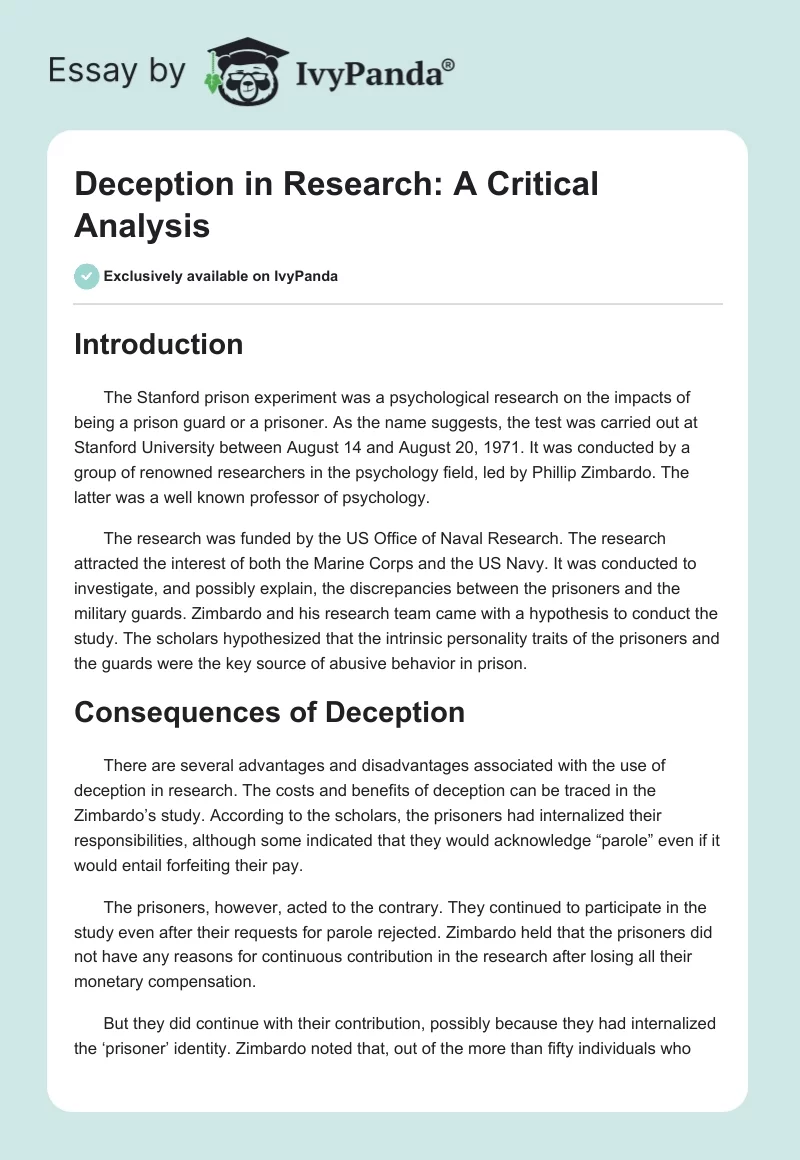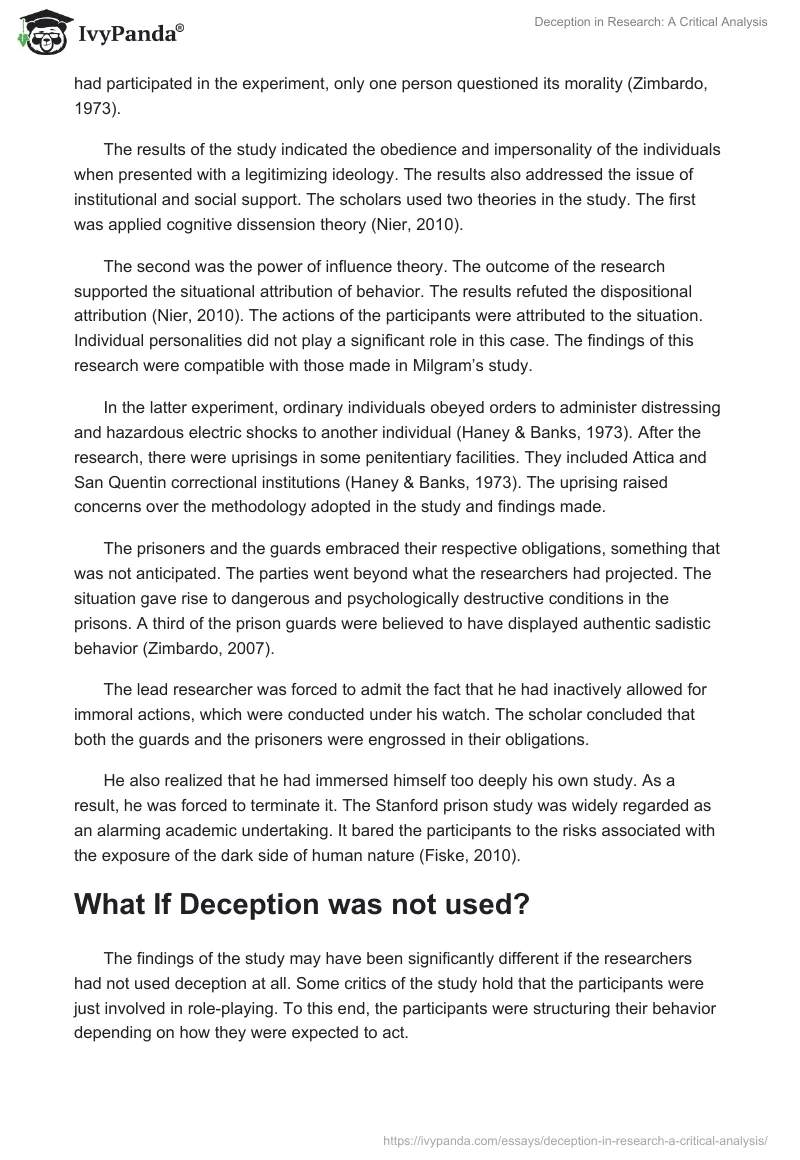Introduction
The Stanford prison experiment was a psychological research on the impacts of being a prison guard or a prisoner. As the name suggests, the test was carried out at Stanford University between August 14 and August 20, 1971. It was conducted by a group of renowned researchers in the psychology field, led by Phillip Zimbardo. The latter was a well known professor of psychology.
The research was funded by the US Office of Naval Research. The research attracted the interest of both the Marine Corps and the US Navy. It was conducted to investigate, and possibly explain, the discrepancies between the prisoners and the military guards. Zimbardo and his research team came with a hypothesis to conduct the study. The scholars hypothesized that the intrinsic personality traits of the prisoners and the guards were the key source of abusive behavior in prison.
Consequences of Deception
There are several advantages and disadvantages associated with the use of deception in research. The costs and benefits of deception can be traced in the Zimbardo’s study. According to the scholars, the prisoners had internalized their responsibilities, although some indicated that they would acknowledge “parole” even if it would entail forfeiting their pay.
The prisoners, however, acted to the contrary. They continued to participate in the study even after their requests for parole rejected. Zimbardo held that the prisoners did not have any reasons for continuous contribution in the research after losing all their monetary compensation.
But they did continue with their contribution, possibly because they had internalized the ‘prisoner’ identity. Zimbardo noted that, out of the more than fifty individuals who had participated in the experiment, only one person questioned its morality (Zimbardo, 1973).
The results of the study indicated the obedience and impersonality of the individuals when presented with a legitimizing ideology. The results also addressed the issue of institutional and social support. The scholars used two theories in the study. The first was applied cognitive dissension theory (Nier, 2010).
The second was the power of influence theory. The outcome of the research supported the situational attribution of behavior. The results refuted the dispositional attribution (Nier, 2010). The actions of the participants were attributed to the situation. Individual personalities did not play a significant role in this case. The findings of this research were compatible with those made in Milgram’s study.
In the latter experiment, ordinary individuals obeyed orders to administer distressing and hazardous electric shocks to another individual (Haney & Banks, 1973). After the research, there were uprisings in some penitentiary facilities. They included Attica and San Quentin correctional institutions (Haney & Banks, 1973). The uprising raised concerns over the methodology adopted in the study and findings made.
The prisoners and the guards embraced their respective obligations, something that was not anticipated. The parties went beyond what the researchers had projected. The situation gave rise to dangerous and psychologically destructive conditions in the prisons. A third of the prison guards were believed to have displayed authentic sadistic behavior (Zimbardo, 2007).
The lead researcher was forced to admit the fact that he had inactively allowed for immoral actions, which were conducted under his watch. The scholar concluded that both the guards and the prisoners were engrossed in their obligations.
He also realized that he had immersed himself too deeply his own study. As a result, he was forced to terminate it. The Stanford prison study was widely regarded as an alarming academic undertaking. It bared the participants to the risks associated with the exposure of the dark side of human nature (Fiske, 2010).
What If Deception was not used?
The findings of the study may have been significantly different if the researchers had not used deception at all. Some critics of the study hold that the participants were just involved in role-playing. To this end, the participants were structuring their behavior depending on how they were expected to act.
They were believed to reproduce their acts according to the stereotypes revolving around the behavior of guards and prisoners. Such behaviors could not have been exhibited if the researchers did not engage in deception. The experiment came out as an examination of the impacts of oppressive leadership.
Because of this, several ambitious guards changed their behavior to match the patterns that the scholars were trying to deduce (Zimbardo, 1973). The change in behavior was one of the major impacts of using deception in the study. Furthermore, the study was condemned on environmental validity basis.
Several conditions established in the study were subjective. The conditions were not connected to real-life situations. A case in point is the blindfolding of new prisoners. The prisoners were prohibited from wearing underwear or looking out of the window.
Conclusion
In summary, the study (which was intended to establish whether or not the intrinsic personality traits of prisoners and guards were the key sources of abusive behavior in prison) did not get the desired results. The main reason for this was the use of deception. The results obtained were not in line with what the researchers had anticipated.
The researchers conducted the study under unfavorable conditions. If deception had not been used, then both prisoners and guards would have behaved as anticipated. Therefore, the use of deception in social-psychological research produces undesired results.
References
Fiske, S.T. (2010). Social beings: Core motives in social psychology. London: Wiley.
Haney, C., & Banks, W. C. (1973). Interpersonal dynamics in a simulated prison. International Journal of Criminology and Penology, 1, 69-97.
Nier, J. (2010). Taking sides: Clashing views in social psychology. London: McGraw-Hill Higher Education.
Zimbardo, P. (1973). The mind is a formidable jailer: A Pirandellian prison. New York: Free Press.
Zimbardo, P. (2007). The Lucifer effect: Understanding how good people turn evil. New York: Random House.


